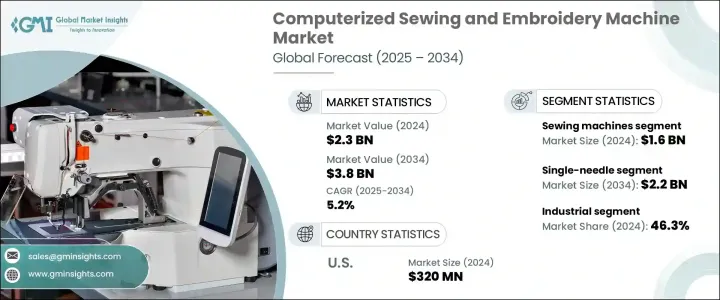
|
시장보고서
상품코드
1766229
컴퓨터 재봉 및 자수 기계 시장 기회, 성장 촉진요인, 산업 동향 분석, 예측(2025-2034년)Computerized Sewing and Embroidery Machine Market Opportunity, Growth Drivers, Industry Trend Analysis, and Forecast 2025 - 2034 |
||||||
세계의 컴퓨터 재봉 및 자수 기계 시장은 2024년에 23억 달러로 평가되었고 CAGR 5.2%를 나타내며 2034년에는 38억 달러에 이를 것으로 추정되고 있습니다.
이 성장 궤도는 주로 세계 섬유 산업의 지속적인 확대에 의해 지원되고 있습니다. 이러한 수요에 부응하는 데 중요한 역할을 하고 있습니다. 이 재봉틀은 수작업에 필요한 시간의 몇 분의 한 번에 복잡하고 세련된 재단을 재현하는 능력으로 특히 지지되고 있습니다.

온라인 소매의 보급과 소비자의 기호의 변화는 맞춤화된 세련된 의류에 대한 수요에 큰 영향을 주고 있습니다. 정밀도에 타협하지 않고 높은 생산성 기준을 충족할 수 있는 자동화 솔루션에 눈을 돌리고 있습니다. 또한, 세계적인 시장 역학과 섬유 섹터의 끊임없는 정책 전환이 경쟁을 격화시켜, 각 회사는 제품의 혁신과 업그레이드를 강요하고 있습니다. 공학의 통합이 경쟁력 유지의 중심이 되고 있으며, 컴퓨터화된 재봉틀은 급속히 진화하는 업계에서 우위를 차지하고자 하는 대규모 제조업체와 소규모 생산 유닛 모두에게 필수적입니다.
| 시장 범위 | |
|---|---|
| 시작 연도 | 2024년 |
| 예측 연도 | 2025-2034년 |
| 시작 금액 | 23억 달러 |
| 예측 금액 | 38억 달러 |
| CAGR | 5.2% |
유형별로 보면 시장은 재봉틀, 자수 재봉틀, 복합기로 구분됩니다. 자동 실 절단, 패턴 커스터마이즈, 간단한 솔기 선택 등의 기능 강화는 현재는 새로운 모델에 표준 장비되어 있어 사용자가 보다 편리하게 고품질의 의복을 생산하는 데 도움이 되고 있습니다.
시장을 카테고리별로 분류하면 싱글 니들 기계와 멀티 니들 기계로 분류됩니다. 정확도, 사용 편의성으로 지지를 받고 있습니다. 오퍼레이터가 봉제 패턴을 조정하고 실시간으로 성능을 모니터할 수 있는 디지털 제어를 탑재한 업그레이드도 늘어나고 있습니다.
시장은 용도에 근거하여 주택용, 상업용, 산업용으로 구분됩니다. 이 시스템은 가동 중지 시간없이 장기간 사용하기 위해 설계되었으며 지속적인 생산 환경에 이상적입니다.
미국 시장은 2024년 3억 2,000만 달러를 돌파했으며 2034년까지 연평균 복합 성장률(CAGR) 5.2%를 나타낼 것으로 예측됩니다. 이 성장은 활기찬 패션 에코시스템과 강력한 DIY 문화가 정교하고 사용하기 쉬운 기계에 대한 수요를 밀어 올리는 것이 주요 요인입니다. 스마트 기술의 채택이 증가하고 있는 것도 장비 업그레이드에 박차를 가하고 있습니다.
컴퓨터 재봉 및 자수 기계 시장 제조업체는 시장에서의 지위를 강화하기 위해 여러 전략을 활용하고 있습니다. 기업은 또한 환경 친화적인 소재와 에너지 효율적인 기술을 모색하여 지속가능성 수요에 부응하고 있습니다.
목차
제1장 조사 방법과 범위
제2장 주요 요약
제3장 업계 인사이트
- 생태계 분석
- 공급자의 상황
- 이익률
- 각 단계에서의 부가가치
- 밸류체인에 영향을 주는 요인
- 업계에 미치는 영향요인
- 성장 촉진요인
- 업계의 잠재적 위험 및 과제
- 기회
- 성장 가능성 분석
- 향후 시장 동향
- 기술과 혁신의 상황
- 현재의 기술 동향
- 신흥기술
- 가격 동향
- 지역별
- 유형별
- 규제 상황
- 표준 및 규정 준수 요건
- 지역 규제 틀
- 인증기준
- Porter's Five Forces 분석
- PESTEL 분석
제4장 경쟁 구도
- 서론
- 기업의 시장 점유율 분석
- 지역별
- 북미
- 유럽
- 아시아태평양
- 중동 및 아프리카
- 라틴아메리카
- 지역별
- 기업 매트릭스 분석
- 주요 시장 기업의 경쟁 분석
- 경쟁 포지셔닝 매트릭스
- 주요 발전
- 합병과 인수
- 파트너십 및 협업
- 신제품 발매
- 확장 계획
제5장 시장 추계·예측 : 유형별(2021-2034년)
- 주요 동향
- 재봉 기계
- 자수 기계
- 복합 기계
제6장 시장 추계·예측 : 스피드별(2021-2034년)
- 주요 동향
- 최대 500 SPM
- 500-1,000 SPM
- 1,000-1,500 SPM
- 1,500-2,000 SPM
- 2,500-3,000 SPM
- 3,000 SPM 이상
제7장 시장 추계·예측 : 카테고리별(2021-2034년)
- 주요 동향
- 단일 바늘
- 멀티 바늘
제8장 시장 추계·예측 : 용도별(2021-2034년)
- 주요 동향
- 주택용
- 상업용
- 패션 디자이너 및 부티크
- 맞춤 자수 상점
- 홈 텍스타일 소매업체
- 실내 장식 사업
- 산업
- 대규모 의류 제조업체
- 자동차 인테리어 제조업체
- 의료 섬유 제조업체
- 유니폼 공급업체
- 기타
제9장 시장 추계·예측 : 유통 채널별(2021-2034년)
- 주요 동향
- 직접 판매
- 간접 판매
- 대형 슈퍼마켓
- 전문점
- 온라인 소매업체
- 독립 딜러
제10장 시장 추계·예측 : 지역별(2021-2034년)
- 주요 동향
- 북미
- 미국
- 캐나다
- 유럽
- 독일
- 영국
- 프랑스
- 이탈리아
- 스페인
- 아시아태평양
- 중국
- 인도
- 일본
- 한국
- 호주
- 라틴아메리카
- 브라질
- 멕시코
- 중동 및 아프리카
- 사우디아라비아
- 아랍에미리트(UAE)
- 남아프리카
제11장 기업 프로파일
- Baby Lock
- Bernina International AG
- Brother Industries Ltd.
- Durkopp Adler AG
- Elna International Corp. SA
- Husqvarna AB
- Janome Sewing Machine Co. Ltd.
- Juki Corporation
- Necchi Italia Srl
- Pfaff Sewing Machines
- Ricoma International Corporation
- SunStar Precision Co. Ltd.
- Tajima Industries Ltd.
- The Singer Company Limited LLC
- ZSK Stickmaschinen GmbH
The Global Computerized Sewing and Embroidery Machine Market was valued at USD 2.3 billion in 2024 and is estimated to grow at a CAGR of 5.2% to reach USD 3.8 billion by 2034. This growth trajectory is primarily supported by the continuous expansion of the global textile industry. As global demand for apparel increases in response to population growth and lifestyle changes, the textile industry is witnessing sustained momentum. Computerized sewing and embroidery machines play a critical role in meeting this demand by enabling high-volume garment production with minimal maintenance and consistent quality. These machines are particularly favored for their ability to replicate intricate and refined tailoring in a fraction of the time required by manual labor.

The proliferation of online retail and changing consumer preferences have significantly influenced the demand for customized and fashionable clothing. With a growing appetite for fast fashion and unique designs, manufacturers are turning to automated solutions that can meet high productivity standards without compromising on precision. The development of organized retail networks, particularly in urban areas, has further encouraged the adoption of sewing and embroidery machines across different end-use settings. Moreover, global market dynamics and constant policy shifts in the textile sector are amplifying competition, compelling manufacturers to innovate and upgrade their offerings. As a result, the integration of advanced features and smart technologies has become central to staying competitive, making computerized machines indispensable for both large-scale manufacturers and small production units aiming to stay ahead in a rapidly evolving industry.
| Market Scope | |
|---|---|
| Start Year | 2024 |
| Forecast Year | 2025-2034 |
| Start Value | $2.3 Billion |
| Forecast Value | $3.8 Billion |
| CAGR | 5.2% |
In terms of type, the market is segmented into sewing machines, embroidery machines, and combination machines. Among these, sewing machines accounted for a significant portion, exceeding USD 1.6 billion in 2024, and are expected to grow at a CAGR of approximately 4.9% from 2025 to 2034. These machines enjoy widespread use across households and industries alike due to their adaptability, simplicity, and cost-efficiency. Enhanced functionalities such as automatic thread cutting, pattern customization, and easy stitch selection are now standard in newer models, helping users produce high-quality garments with greater convenience. Policy support aimed at boosting local textile manufacturing has also contributed to the growth of this segment by making modern equipment more accessible.
When segmented by category, the market is classified into single-needle and multi-needle machines. The single-needle category held the largest share in 2024, capturing 60.8% of the total market, and is expected to reach USD 2.2 billion by 2034. Single-needle machines are favored for their speed, precision, and ease of use in standard garment production. They are increasingly being upgraded with digital controls that allow operators to adjust stitching patterns and monitor performance in real time. The demand for advanced single-needle machines is particularly strong in mature markets where quality standards are high and consumer expectations continue to evolve.
Based on application, the market is segmented into residential, commercial, and industrial categories. The industrial segment led the market in 2024 with a 46.3% share and is expected to maintain this position throughout the forecast period. Industrial-grade machines are essential for high-capacity operations where durability and speed are critical. These systems are engineered to handle extended usage without downtime, making them ideal for continuous production environments. Countries with a strong textile base and supportive government policies aimed at modernizing manufacturing infrastructure are contributing to the sustained growth of this segment.
The United States market surpassed USD 320 million in 2024 and is anticipated to grow at a CAGR of 5.2% through 2034. This growth is largely driven by a vibrant fashion ecosystem and a strong do-it-yourself culture, both of which are pushing the demand for sophisticated and user-friendly machines. The increasing adoption of automation and smart technologies in textile production is also fueling equipment upgrades. Import data reflects a consistent rise in the inflow of high-tech machinery designed for enhanced productivity and operational efficiency.
Manufacturers in the computerized sewing and embroidery machine market are leveraging multiple strategies to reinforce their market position. These include rolling out technologically advanced products, pursuing global expansion, establishing strategic alliances, and diversifying product portfolios to target various consumer segments. Companies are also responding to sustainability demands by exploring eco-friendly materials and energy-efficient technologies. Moreover, aligning with regional distributors and local retail partners has proven effective for market penetration, particularly in emerging economies.
Table of Contents
Chapter 1 Methodology and Scope
- 1.1 Market scope and definition
- 1.2 Research design
- 1.2.1 Research approach
- 1.2.2 Data collection methods
- 1.3 Data mining sources
- 1.3.1 Global
- 1.3.2 Regional/Country
- 1.4 Base estimates and calculations
- 1.4.1 Base year calculation
- 1.4.2 Key trends for market estimation
- 1.5 Primary research and validation
- 1.5.1 Primary sources
- 1.6 Forecast model
- 1.7 Research assumptions and limitations
Chapter 2 Executive Summary
- 2.1 Industry 3600 synopsis
- 2.2 Key market trends
- 2.2.1 Regional
- 2.2.2 Type
- 2.2.3 Speed
- 2.2.4 Category
- 2.2.5 Application
- 2.2.6 Distribution channel
- 2.3 CXO perspectives: Strategic imperatives
- 2.3.1 Key decision points for industry executives
- 2.3.2 Critical success factors for market players
- 2.4 Future Outlook and Strategic Recommendations
Chapter 3 Industry Insights
- 3.1 Industry ecosystem analysis
- 3.1.1 Supplier Landscape
- 3.1.2 Profit Margin
- 3.1.3 Value addition at each stage
- 3.1.4 Factor affecting the value chain
- 3.2 Industry impact forces
- 3.2.1 Growth drivers
- 3.2.2 Industry pitfalls & challenges
- 3.2.3 Opportunities
- 3.3 Growth potential analysis
- 3.4 Future market trends
- 3.5 Technology and Innovation landscape
- 3.5.1 Current technological trends
- 3.5.2 Emerging technologies
- 3.6 Price trends
- 3.6.1 By region
- 3.6.2 By type
- 3.7 Regulatory landscape
- 3.7.1 Standards and compliance requirements
- 3.7.2 Regional regulatory frameworks
- 3.7.3 Certification standards
- 3.8 Porter's analysis
- 3.9 PESTEL analysis
Chapter 4 Competitive Landscape, 2024
- 4.1 Introduction
- 4.2 Company market share analysis
- 4.2.1 By region
- 4.2.1.1 North America
- 4.2.1.2 Europe
- 4.2.1.3 Asia Pacific
- 4.2.1.4 MEA
- 4.2.1.5 LATAM
- 4.2.1 By region
- 4.3 Company matrix analysis
- 4.4 Competitive analysis of major market players
- 4.5 Competitive positioning matrix
- 4.6 Key developments
- 4.6.1 Mergers & acquisitions
- 4.6.2 Partnerships & collaborations
- 4.6.3 New Product Launches
- 4.6.4 Expansion Plans
Chapter 5 Market Estimates & Forecast, By Type, 2021 - 2034, (USD Billion)(Thousand Units)
- 5.1 Key trends
- 5.2 Sewing machines
- 5.3 Embroidery machines
- 5.4 Combination machines
Chapter 6 Market Estimates & Forecast, By Speed, 2021 - 2034, (USD Billion)(Thousand Units)
- 6.1 Key trends
- 6.2 Up to 500 SPM
- 6.3 500-1,000 SPM
- 6.4 1,000-1,500 SPM
- 6.5 1,500-2,000 SPM
- 6.6 2,500-3,000 SPM
- 6.7 Above 3,000 SPM
Chapter 7 Market Estimates & Forecast, By Category, 2021 - 2034, (USD Billion)(Thousand Units)
- 7.1 Key trends
- 7.2 Single?needle
- 7.3 Multi?needle
Chapter 8 Market Estimates & Forecast, By Application, 2021 - 2034, (USD Billion)(Thousand Units)
- 8.1 Key trends
- 8.2 Residential
- 8.3 Commercial
- 8.3.1 Fashion designers & boutiques
- 8.3.2 Custom embroidery shops
- 8.3.3 Home textile retailers
- 8.3.4 Upholstery businesses
- 8.4 Industrial
- 8.4.1 Large?Scale apparel manufacturers
- 8.4.2 Automotive interior manufacturers
- 8.4.3 Healthcare textile manufacturers
- 8.4.4 Uniform suppliers
- 8.4.5 Others
Chapter 9 Market Estimates & Forecast, By Distribution Channel, 2021 - 2034, (USD Billion)(Thousand Units)
- 9.1 Key trends
- 9.2 Direct sales
- 9.3 Indirect sales
- 9.3.1 Hypermarkets
- 9.3.2 Specialty stores
- 9.3.3 Online retailers
- 9.3.4 Independent dealers
Chapter 10 Market Estimates & Forecast, By Region, 2021 - 2034, (USD Billion)(Thousand Units)
- 10.1 Key trends
- 10.2 North America
- 10.2.1 U.S.
- 10.2.2 Canada
- 10.3 Europe
- 10.3.1 Germany
- 10.3.2 UK
- 10.3.3 France
- 10.3.4 Italy
- 10.3.5 Spain
- 10.4 Asia Pacific
- 10.4.1 China
- 10.4.2 India
- 10.4.3 Japan
- 10.4.4 South Korea
- 10.4.5 Australia
- 10.5 Latin America
- 10.5.1 Brazil
- 10.5.2 Mexico
- 10.6 MEA
- 10.6.1 Saudi Arabia
- 10.6.2 UAE
- 10.6.3 South Africa
Chapter 11 Company Profiles (Business Overview, Financial Data, Product Landscape, Strategic Outlook, SWOT Analysis)
- 11.1 Baby Lock
- 11.2 Bernina International AG
- 11.3 Brother Industries Ltd.
- 11.4 Durkopp Adler AG
- 11.5 Elna International Corp. SA
- 11.6 Husqvarna AB
- 11.7 Janome Sewing Machine Co., Ltd.
- 11.8 Juki Corporation
- 11.9 Necchi Italia S.r.l.
- 11.10 Pfaff Sewing Machines
- 11.11 Ricoma International Corporation
- 11.12 SunStar Precision Co., Ltd.
- 11.13 Tajima Industries Ltd.
- 11.14 The Singer Company Limited LLC
- 11.15 ZSK Stickmaschinen GmbH



















